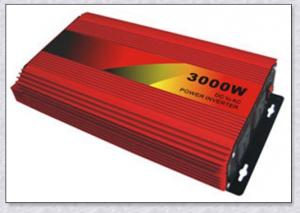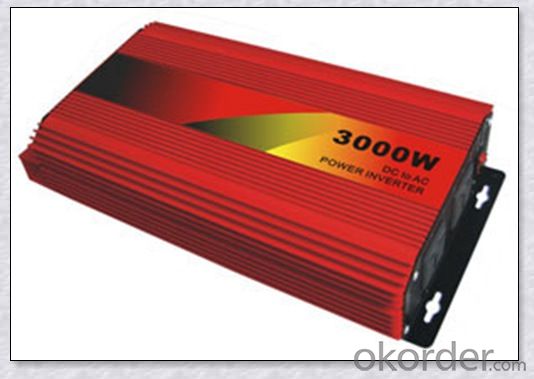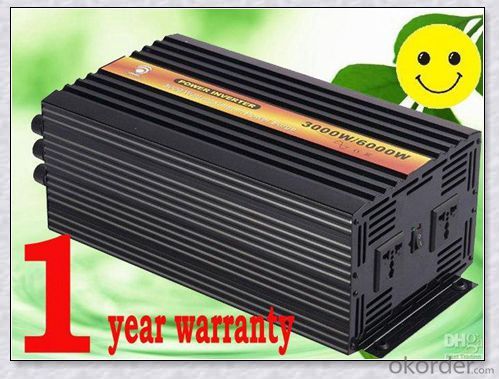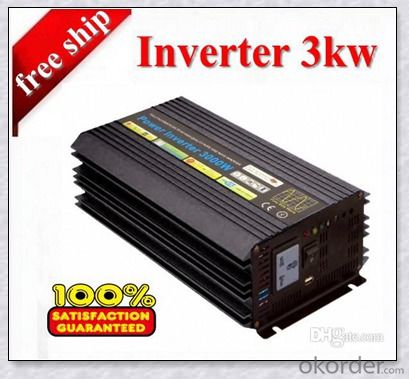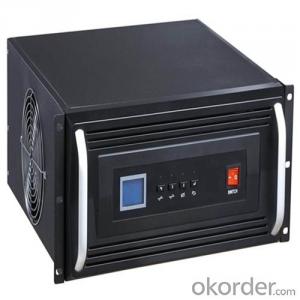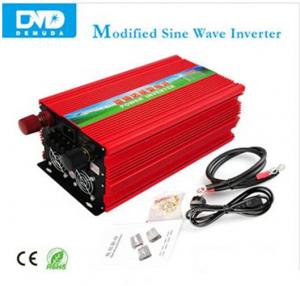Solar Inverter Cage 24V 3000W Leading-Edge Technology
OKorder Service Pledge
OKorder Financial Service
You Might Also Like
Descriptions:
All of our grid-tie inverters are UL listed and code-compliant. We do not stock refurbished grid-tie inverters. Because grid-tie inverters have stricter requirements than off grid inverters, refurbished grid-tie inverters may not be code-compliant. Check with your local electrician or building department before investing in a refurbished grid-tie inverter.
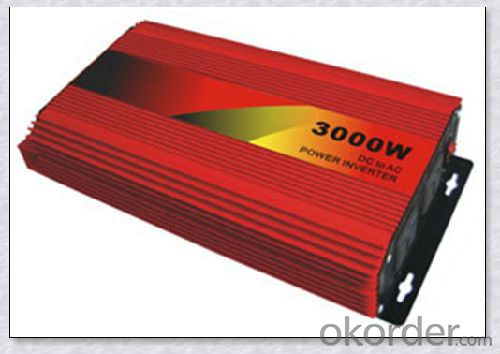
Specifications
INPUT | |
Input voltage range | 185~265±5Vac |
OUTPUT | |
Output voltage range | 185~265±5Vac (AC mode) , 230Vac (DC mode) |
Output frequency (DC mode) | 50Hz (48~54Hz) or 60Hz(58~64Hz), same as AC(AC mode) 50Hz ±0.3Hz (DC mode) |
Wave form | Sine wave (DC Mode) |
Transfer time | 10ms. (Typical) |
BATTERY | |
Rated charging current (max.) | 45A |
Norminal DC input voltage | 24V |
Min. DC start voltage | 20V / 40V |
PHYSICAL | |
Unit dimension (mm) | 526*277*212 |
Master box dimension (mm) | 620*350*370 |
Net weight (1pc, kg) | 32.4 |
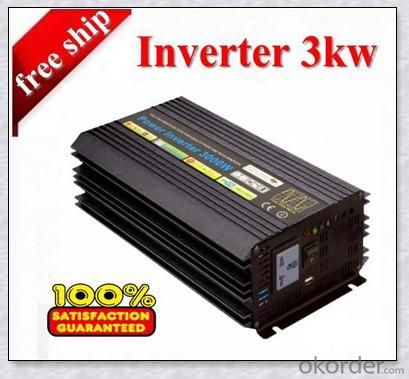
Electronic Protections:
·PV short circuit protection
·PV reverse polarity protection
·PV overvoltage alarm protection
·PV over current protection
·Battery overcharge protection
·Battery over discharge protection
·Battery reverse polarity protection
·Load short circuit protection
·Load overload protection
FAQ:
Q: Do you have any MOQ limit?
Our MOQ is 200 pieces.
Q: Do you offer guarantee for the products?
Yes, we offer one year guarantee for the products.
- Q: How does a solar inverter handle variations in ambient temperature?
- A solar inverter is designed to handle variations in ambient temperature by incorporating temperature compensation algorithms. These algorithms adjust the inverter's performance parameters, such as voltage and frequency, based on temperature measurements. This ensures that the inverter operates optimally and efficiently across a wide range of temperature conditions, maintaining stable and reliable power conversion from the solar panels.
- Q: Can a solar inverter be used with a solar-powered remote monitoring system?
- Yes, a solar inverter can be used with a solar-powered remote monitoring system. The solar inverter is responsible for converting the direct current (DC) generated by the solar panels into alternating current (AC) that can be used to power various devices, including the remote monitoring system. This allows the remote monitoring system to be powered by the solar panels and ensures that it operates efficiently.
- Q: Are there any government incentives for installing a solar inverter?
- Yes, there are government incentives for installing a solar inverter. Many countries offer financial incentives such as tax credits, grants, or rebates to encourage the adoption of renewable energy technologies like solar inverters. Additionally, some regions may have specific programs or initiatives that provide additional support or incentives for solar inverter installations. It is advisable to research and consult with local authorities or renewable energy organizations to determine the specific incentives available in your area.
- Q: How does a solar inverter protect against short circuits?
- A solar inverter protects against short circuits by incorporating protective devices such as fuses or circuit breakers in its design. These protective devices are designed to detect high current flow caused by a short circuit and quickly interrupt the circuit, preventing any damage or overheating that could occur. Additionally, advanced solar inverters may also include built-in monitoring systems that constantly monitor the electrical parameters and shut down the inverter in case of a short circuit to ensure safety and prevent further damage.
- Q: How does a solar inverter handle reverse power flow?
- A solar inverter handles reverse power flow by automatically detecting the excess power generated by the solar panels and converting it into usable AC power for the electrical grid. It is designed to seamlessly switch between supplying power to the grid and receiving power from it, ensuring efficient utilization of solar energy while maintaining grid stability.
- Q: What is the difference between a PV inverter and a solar inverter?
- Instability, the wind speed and the equipment itself will directly affect the generator rotation, so the voltage and current fluctuations, frequency instability, in short, is the power quality is poor) Therefore, through the inverter after the first rectification inverter to improve the quality of power
- Q: What is the role of a voltage control unit in a solar inverter?
- The role of a voltage control unit in a solar inverter is to regulate and maintain a consistent output voltage from the solar panels. It ensures that the electricity generated by the panels is converted and supplied at the appropriate voltage levels to meet the requirements of the connected devices or the grid. By controlling the voltage, it helps optimize the efficiency and reliability of the solar inverter system.
- Q: Can a solar inverter be used in remote areas?
- Yes, a solar inverter can be used in remote areas. Solar inverters are designed to convert the direct current (DC) produced by solar panels into alternating current (AC) that can be used to power electrical devices. As long as there is access to sunlight, solar panels can generate electricity, making solar inverters suitable for remote areas that may not have access to the traditional power grid.
- Q: What is the maximum output voltage of a solar inverter?
- The maximum output voltage of a solar inverter is typically determined by the specific model and specifications of the inverter being used. It can vary depending on factors such as the size and configuration of the solar array it is connected to. Generally, for residential solar installations, the maximum output voltage of a solar inverter can range from 230V to 240V for single-phase systems, and up to 400V for three-phase systems.
- Q: Are there any voltage or frequency regulations for solar inverters?
- Yes, there are voltage and frequency regulations for solar inverters. These regulations vary from country to country and are typically set by regulatory bodies or standardization organizations. In most countries, solar inverters must comply with specific voltage and frequency limits to ensure the safe and reliable operation of the electrical grid. Voltage regulations specify the allowable range of output voltage that a solar inverter can provide to the grid. This ensures that the voltage remains within acceptable limits to prevent overvoltage or undervoltage conditions that could damage electrical equipment or disrupt the grid's stability. The specific voltage limits depend on factors such as the type of grid system (e.g., single-phase or three-phase) and the voltage levels used in the country. Frequency regulations, on the other hand, define the acceptable range of output frequency that a solar inverter can provide to the grid. Grid frequency is typically set at a specific value (e.g., 50 Hz or 60 Hz) and solar inverters must synchronize their output frequency with the grid to ensure compatibility. Deviations from the specified frequency can lead to issues such as equipment malfunction or instability in the grid. Compliance with voltage and frequency regulations is crucial for solar inverters to ensure the proper integration of renewable energy sources into the electrical grid. In many countries, solar inverters must adhere to specific technical standards or certifications to demonstrate their compliance with these regulations. These standards often cover various aspects of inverter performance, including voltage and frequency control, power quality, and grid interaction.
Send your message to us
Solar Inverter Cage 24V 3000W Leading-Edge Technology
OKorder Service Pledge
OKorder Financial Service
Similar products
Hot products
Hot Searches
Related keywords
